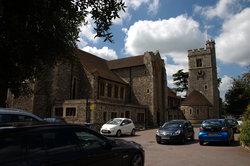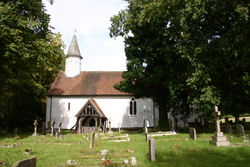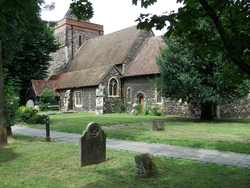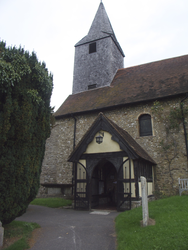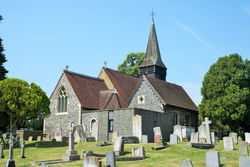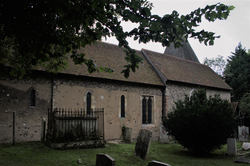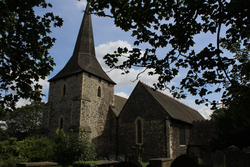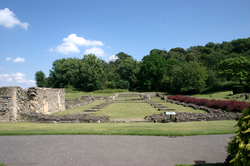
The Corpus of ROMANESQUE SCULPTURE in Britain & Ireland

Rochester (now)
Parish church
Bromley is a large town formerly in Kent, but now in Greater London. The medieval church was almost totally destroyed by wartime bombing in 1941 leaving only the tower, the earliest parts of which probably date from the 14thc. A new church, incorporating the tower, was built between 1948 and 1957 on a site adjacent to that of the old church. The only Romanesque sculpture remaining is the font bowl.
Parish church
Fawkham is a village in NE Kent, about 8 miles from Gravesend and 12 miles from Sevenoaks. The church of St Mary consists of a Norman nave and a chancel with Decorated windows, and the vestry to the N and S porch added in the 19thc. The nave features a 16th-c octagonal weatherboarded bell turret surmounted by a shingled spire. The interior has bellcote supports of four posts braced at the top with pierced spandrels within the braces and a 13th-c wall painting of Christ in Majesty in the nave. Some medieval stained glass fragments are found in the S window of the chancel. The only surviving Romanesque sculptural element is a tub font.
Parish church
Rainham is a suburban town in the London Borough of Havering, but traditionally in Essex. It is on the N bank of the Thames, E of Dagenham and separated from the river by Rainham Marshes. The church is in the old centre, and is the only medieval building still standing. 20thc expansion has largely proceeded to the W. St Helen and St Giles is a remarkably complete later 12thc church, consisting of a chancel, a nave with N and S aisles, and a S porch, and a W tower with some 12thc lancets and a replacement brick parapet with a pyramid roof. Construction is of flint and stone rubble with ashlar dressings. The church was restored by Rev. Ernest Geldart (1897-1910). Romanesque features covered here are the doorways in the N nave aisle and on either side of the chancel as well as the E oculus on the exterior, and inside, the nave arcades, chancel and tower arches, font and a piscina in the S nave aisle.
Parish church
The parish church of St Mary is of mostly later medieval date in a large historic village in the west of Kent, 4 miles NE of Sevenoaks. The sole Romanesque feature may be a jewelled-cut font of uncertain date.
Parish church
Foots Cray is an area of SE Sidcup, now in the London borough of Bexley but formerly part of Kent. The church of All Saints was enthusiastically described by Glynne as 'a small rustic church, beautifully situated in a churchyard surrounded by trees'. The building of flint with stone bands and dressings and red tile roof consists of a nave with W porch, chancel, S chapel, N vestries and organ chamber, and a wooden bell tower over nave, with shingled broached spire. The church was largely rebuilt circa 1863 by Henry Hakewill, although the W spire and W porch belong to an earlier church, as also the single lancet, two Perpendicular windows and the wide arch to the N aisle. The only surviving Romanesque feature is the late 12thc font, with water-leaf capitals to corner shafts.
Parish church
St Margaret of Antioch, Darenth, is 3 miles SE of Dartford, Kent. The church is Grade 1 listed and has a 13thc. W tower, nave, 15thc. aisle and modern vestry. There is a stone-vaulted chancel with a blocked Transitional Gothic S arcade. The font is a fine example of Romanesque sculpture and there are some re-set Romanesque corbels.
Parish church
Erith today is a town near Bexley, SE London, but formerly in the historic county of Kent. The church of St John the Baptist is one of six ancient churches in the area, located near a bend in the River Thames. It has a nave with aisles, a chancel and a W tower. Although most of the fabric is 13thc. or later, there is a selection of reset Romanesque material in the nave and tower.
Ruined church, formerly Augustinian abbey
The ruins of Lesnes Abbey lie between Abbey Road and Lesnes Abbey Woods at Belvedere, formerly part of Kent but now in the London borough of Bexley in SE London. In the Middle Ages the river Thames and its marshland were much closer to the abbey.
The ruins include the restored foundations of the abbey church. The church was set out during the founder's lifetime (d. 1179), and consisted of an aisled nave, transepts with three eastern chapels on each side, and an aisleless presbytery. The total internal length of the church was 234 ft. and 66 ft. across the transepts; this makes it one of the largest Augustinian naves in Britain. The abbey was built of Kentish ragstone, flint and chalk.
The ruins were excavated by the Woolwich Antiquarian Society in 1909, up to 1930 by Sir Alfred Clapham, and between 1939 and 1951 by E C Elliston Erwood for the London County Council who owned them at that time.
